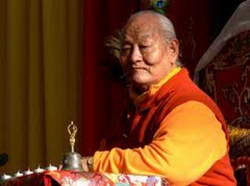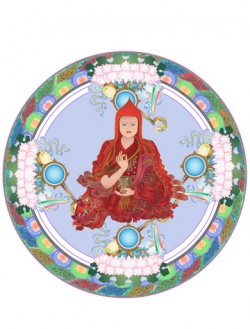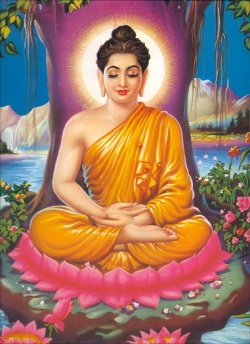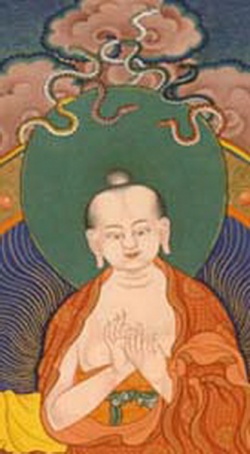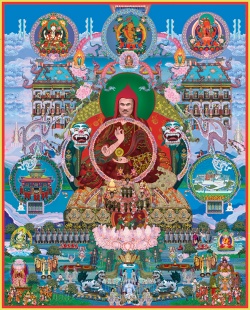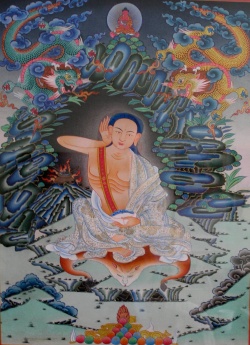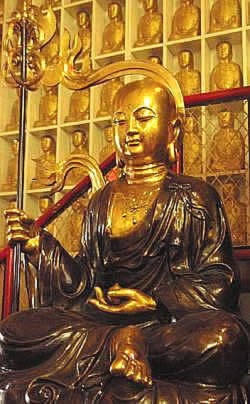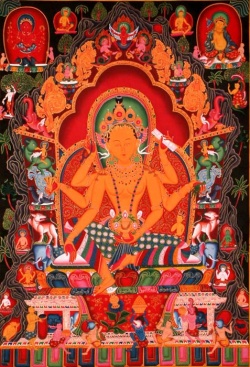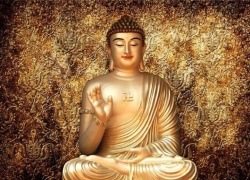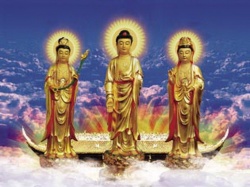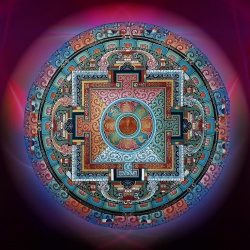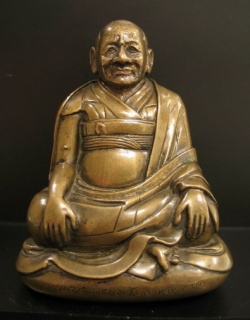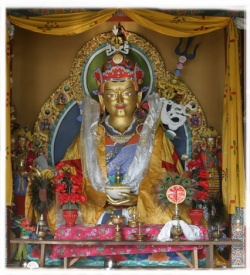Brief Survey of Self-Voidness and Other-Voidness Views
Alexander Berzin
Morelia, Mexico, April 2006
Unedited Transcript
I’ve been asked today to speak a little bit about the two views of voidness, rangtong (rang-stong) and zhentong (gzhan-stong) in Tibetan – that’s self-voidness and other-voidness.
Self-voidness is short for voidness of a self-establishing nature.
Whereas other-voidness is short for voidness of other tainted factors, let’s call them, which is referring primarily to other levels of mind.
Now the study of voidness emptiness is something which is unbelievably complicated.
It would be complicated if there was only one view of voidness, and one school with one view of voidness, but that unfortunately is not the case.
When we speak of voidness, we’re speaking of an absence of something.
And there are many different types of absences. There’s no need to go into that, at least at the moment, although that’s very important to understand – what absences are.
But in all the four tenet systems, and the subdivisions of the four Indian Buddhist tenet systems, we have a discussion of an absence – actually a discussion of several types of absences in each of the schools.
In the two Hinayana tenet systems, Vaibhashika and Sautrantika, they don’t use the term voidness, but they speak of a lack of an impossible soul of persons.
But although they’re not using the word voidness, they’re speaking about no such thing as this type of impossible soul.
In the Mahayana schools, Chittamatra and Madhyamaka, and the various divisions of Madhyamaka, we do find the term voidness.
And it’s used in reference to an absence of impossible ways of existing of all phenomena.
Now we have, in the discussion of impossible ways of existing, many different types of existence that are discussed.
And what we’re actually speaking about here is how do you establish the existence of something or what establishes the existence of something.
For example, we could say in the Sautrantika school (the Gelugpa version of the Sautrantika school) that something is truly established – true existence – it’s truly established if it produces an effect: the fact that it produces an effect establishes that it truly exists.
Now in each of the tenet systems there’s going to be a different definition of each of these many different types of ways of establishing that something exists.
So the same terminology is going to be defined differently in the different schools.
This makes it rather confusing.
For instance, truly established existence is defined differently in the different schools and, according to the school of tenets, either truly established existence truly does exist or it doesn’t.
Now, to make it more complicated, within one Tibetan tradition – leave aside what the Indian various proponents of each of these systems, how they differed from each other – but within the Tibetan schools,
the Tibetan traditions, even within one tradition… Well, first of all, the various traditions in Tibet have quite radically different understandings of these Indian tenet systems.
Really different. And even within one Tibetan tradition – for instance the Gelug tradition, which is what I’m most familiar with – the textbooks of the various monasteries within Gelugpa are going to give different interpretations of several points concerning these tenet systems, particularly concerning definitions. So this becomes a bit bewildering.
Therefore it is very important not to mix different interpretation systems of the four tenet systems and particularly the discussion of voidness.
And of course one can’t understand the assertions of voidness in any particular system separate from the assertions of other points of philosophy.
For example, how you know things, what are valid ways of knowing things, and so on – the presentation of relative truth.
So how do we actually approach studying this material?
This is not a simple task. I think the first step is to acknowledge that we are only going to get a rough understanding to start with.
In other words, we try to understand in the beginning the general concepts that we’re speaking about in this whole issue of voidness, and to try to learn one system of interpretation.
And while doing that, always be aware that this is not the only way of explaining it, and not to have attachment to “This is absolutely correct and any other explanation is wrong.”
One danger that you have to really watch out for – and it’s very difficult to avoid this danger –
is that when you’re studying one particular interpretation system and you have to fill in a point that you don’t really know what this system says, then naturally we fill it in from another system that we know.
And sometimes that fits into the original interpretation system and sometimes it doesn’t.
And when it doesn’t, that produces a lot of confusion and misunderstanding. And if you’re not an expert, you don’t know.
So what is the result of this?
The result of this is to not expect that you’re going to understand these teachings clearly.
Don’t have that expectation. You’re going to be confused; you’re going to find a lot of things that seem contradictory.
That’s only natural. Don’t think that the material itself is stupid.
The problem is we don’t have sufficient information and we don’t have sufficient familiarity with this type of discussion.
Therefore the process is always – as the years pass by and we learn more, and we study more, and we study various systems, and we go more and more deeply into one or another system, things will become a little bit more clear.
We’ll all of a sudden learn… I mean, I just learned today – I had no idea that Karma Kagyu had a radically different view of Chittamatra than the Gelugpa one that I’m familiar with; radically different.
So, even when we’ve been studying these systems for many, many years, we discover more and more things that we took for granted that this was accepted, in general, by everybody, and we learn that it’s not. So it’s a constant process of discovery.
We’re learning more – which means that we have to sustain our interest – and refining our understanding more and more.
But, for our own individual practice, it’s important to choose one system and really, really work with that.
It’s too difficult to work with all the systems, in terms of our own individual practice.
Now we may have more information available on one system than another, and that system that we have more information on may not be the one that actually suits us.
That of course is not so easy a situation, is it?
Now if we are in a situation in which we could choose to study, with different learned masters, one system or another, then we get a little bit of a taste of one or another, and then we could go and pursue that.
If we don’t have that opportunity then unfortunately we’re stuck with whatever is available.
This is a very delicate situation and one has to be very careful.
As we study one system more and more deeply that happens to be the only one that’s available to us, then don’t force it – in terms of “This has to suit me.” It may; it may not.
After all, we’re all individuals.
But give it a chance. And when we’re studying other topics besides voidness and if we don’t have the information about this other topic in the same system that we’re studying concerning voidness, at least be aware that there could be differences.
Let’s say you’re studying the valid ways of knowing. There’s a difference between what Gelugpa says concerning Sautrantika and what non-Gelugpa says.
And Gelugpa says that what Sautrantika says and what Prasangika says are different concerning valid ways of knowing.
And their differences are in accord with their view of what Sautrantika and what Prasangika says about voidness.
And that’s essential to know these various ways of knowing because that’s what’s involved in knowing voidness.
So I think, at this stage in our studies, the most helpful attitude is that we are collecting pieces of the jigsaw puzzle.
They might not fit together – in fact, we might be collecting pieces of different jigsaw puzzles – but we need to get the pieces of the puzzle before we can really put them together.
And please remember that the Buddhist training for liberation and enlightenment is not just a training of understanding.
We need to train patience; we need to train perseverance, enthusiasm, dealing with hardships, dealing with difficulties.
And so because the course of study of voidness in these various tenet systems is as difficult as I’ve been explaining it, that helps us to develop patience and perseverance and discipline to go on and on and on,
no matter how confusing and how difficult it is, because our motivation is so strong – of either renunciation or of both renunciation and bodhichitta.
So this type of material which is so confusing and so difficult, and so many different versions – this is very helpful, that it’s like that, because it weeds out those who are not really sincerely interested in liberation and enlightenment, who are just studying it because it’s intellectually interesting; and, like that, you’ll drop out.
After all, one of the bodhisattva vows is never to give up. If we give up on this study because it’s too complicated and too confusing, no way that we could ever achieve liberation or enlightenment.
So we’re building up our character as well through this study, and that is an essential part of the Buddhist training which often we forget.
Okay. Now we get into the topic of self-voidness and other-voidness.
It’s a huge topic. It’s not so easy to explain.
And I’m certainly no expert, particularly not on other-voidness. There are many different views of self-voidness.
There are many different views of other-voidness.
Not just one. Each interpretation system that we’ve been discussing is going to have its own view of what self-voidness and other-voidness are.
So to just do it briefly, and not trying to explain everything – in terms of each view that I only have a little bit of familiarity with – let us just look a little bit at these systems.
Now of course within Madhyamaka there is Svatantrika and Prasangika, and there’s a big discussion whether the Tibetans made up that division or not – whether in India you actually had that.
And different Tibetan interpretation systems are going to explain quite differently the difference between Svatantrika and Prasangika.
Just speaking really in general, not going deeply into subsystems, Sakya and Nyingma don’t make that big a difference between Svatantrika and Prasangika.
The main difference, they say, is in the form of logic that’s used – whether or not they make any positive assertion.
Tsongkhapa, in the Gelugpa tradition, made a big difference between the two.
Tsongkhapa was extremely radical. He was the most revolutionary of any Tibetan master.
He studied with masters from all the traditions that were available in Tibet at the time.
And you know how much he emphasized guru devotion, fully entrusting yourself to the teacher, and yet he refuted all his teachers on almost everything that they taught;
not only the difference between Svatantrika and Prasangika, but almost everything. He certainly didn’t refute 100%, but he refuted a tremendous amount.
And yet there’s no contradiction in doing that and having full respect and entrusting yourself to the teacher. This is not easy to understand.
And many of Tsongkhapa’s teachers also later became his disciples.
They had teacher-disciple reciprocal relations with each other.
But Gelugpa and Karma Kagyu make quite a difference between Svatantrika and Prasangika.
Of course the difference that they make is different, one from the other.
But, you see, what happened was that the Seventh Karmapa (I believe it was the Seventh Karmapa) was a disciple also of Jetsun Jetsunpa Chokyi-gyeltsen –
I’ve forgotten the exact name, but the author of the Jetsunpa text books of Sera Jey and Ganden Jangtsey monasteries.
The Seventh Karmapa was a disciple of this Great Jetsunpa; he lived a few generations after Tsongkhapa and he accepted many of the Gelugpa tenets into Karma Kagyu, but of course integrated that with other views of Karma Kagyu earlier.
So, to just make it very simple, the big difference within Gelugpa concerning these two systems – which are both self-voidness systems – is that in Svatantrika,
what it says is that nothing exists unimputedly; everything is imputed – is established – by the fact that it can be imputed through names and concepts.
What that means is that: How do you establish that something exists?
You establish that it exists because it can be imputed (or labeled) with a name or concept; that’s what establishes that it exists.
But it’s not only that which establishes that it exists, because there are findable characteristic marks on the side of the object which make it what it is, and in conjunction with mental labeling you can establish that it exists.
So relative truth of things: you have these findable characteristic marks.
And deepest truth: no such thing as true unimputed existence.
So already we have this dynamic of something findable on the relative level, but nothing findable on the deepest level.
This comes into the zhentong way of thinking, but it comes into zhentong in an inverted way – which is that on the relative level, everything is false; and on the deepest level, you find a characteristic of the deep awareness that understands reality.
What’s important here is the structure.
The important point that I’m making here – and I’m pointing out – is making a big difference between the two truths of something.
So, on the one hand, Svatantrika says “Relative truth: you find something. Deepest truth: there’s nothing that you find.”
The zhentong say that what you say you find on the relative truth, that doesn’t exist at all; and on the deepest level (which is devoid of that), you do find something – which is this deep awareness.
So making that big difference is the influence of this Svatantrika view and zhentong.
Gelugpa Prasangika is saying that “No” – this is this Svatantrika view that there are findable characteristic features on the relative level – “that is incorrect.
There’s nothing findable on either of the two truths.
There’s nothing findable in terms of these two truths of anything. And things are…”
The way it’s formulated is really difficult because there are several negatives in the statements, so I’ll try to make it the other way, is that
“What establishes that things exist is only that they are imputable, not that they are imputable with a findable characteristic.” So what establishes that things exist is only that they are imputable.
The word only here is very important.
And the way they then express voidness is that things are devoid of not being established only by imputation, or they’re devoid of being established not only by imputation.
That’s why it’s confusing for our minds that aren’t used to expressions with more than one negation in it, but that’s what you’ll see in the texts.
When we talk about voidness, we’re talking here about no such thing.
It’s an absence.
A form of no such thing. And there’s no implication with that.
To get into implicative and nonimplicative negation phenomena is very, very complicated, so let’s just leave it as no such thing.
The difference – just to make it very simple – is: “A table without a tablecloth,” that’s an implicative negation phenomenon (ma-yin dgag).
In other words, when you negate tablecloth – without a tablecloth – there’s a table.
There’s a table without a tablecloth. No tablecloth.
Without a tablecloth. And what is left over after that negation is the table. Okay? The important point is what’s left over after the negation; not what it’s affirming, it’s what’s left over.
Don’t think of it in terms of “it doesn’t negate the table” – that’ll confuse you – think in terms of “what’s left over when you eliminate what’s been negated.”
Whereas if we say, “There are no tablecloths,” that’s nonimplicative (med-dgag); there’s nothing left over.
And if we say, “There’s no tablecloth on the table,” that’s also nonimplicative – there’s nothing left over – because the unit that’s being negated is a tablecloth on the table.
The whole unit that’s being negated is tablecloth on the table.
There’s still nothing left over.
The first one, with something left over, is a table without a tablecloth. Okay? This is important to understand.
So what this Gelugpa self-voidness is saying is that there’s no such thing as truly established existence.No such thing.
And one gets this first of all as a conceptual cognition; and to go to a nonconceptual cognition of that, you have to understand the voidness of that voidness.
Now the non-Gelugpa schools are basically…
The problem is always: How do you go from a conceptual to a nonconceptual cognition of voidness?
That’s the big problem… So they’re saying that there’s some limitation in the way that the Gelugpa is presenting this.
Mind you, they came before the Gelugpa. So let’s look at them just by themselves.
They would say that – to use just simple terminology – if you think in terms of true existence, that’s conceptual; conceptual cognition.
Because it’s imputing true existence when there’s no such thing. Right? It’s projecting true existence.
It is fabricating true existence.
We have this term mental fabrication (spros-pa). So it’s fabricating it.
Right? You have a concept of course, that category, but it doesn’t refer to anything real
Now when you refute true existence, then you have no such thing as true existence.
Well, no such thing as true existence, this also is known conceptually. And so that also is a mental fabrication.
Same thing with both truly existent and nonexistent, or neither of the two – you know, the four possibilities.
Therefore, you need to go beyond these four fabricated categories – truly existent, non-truly existent, both, or neither – to voidness, which is beyond words and beyond concepts.
This is how you get to nonconceptual cognition of voidness.
This is what they call this self-realizing deep awareness (rang-rig ye-shes). Gelugpa would say the equivalent of that is the voidness of voidness.
And when we talk about – in Gelugpa, when Tsongkhapa says – when we talk about voidness of true existence, what’s included in there is the voidness of the four extremes:
truly existent, totally nonexistent, both, or neither.
So we can see that the real issue here is how do you go beyond the conceptual cognition of voidness.
You can also get (and here it becomes a problem) if you say that voidness is not a nonimplicative negation – nonimplicative would be no such thing as true existence – and it’s beyond that, well, then, what is it?
And if you say it’s a consciousness that is beyond concepts and words – that’s an implicative negation, according to Gelugpa.
So that’s what they accuse this whole view of; this is its fault.
Gelugpa says that you can have both a conceptual and a nonconceptual cognition of a nonimplicative negation phenomenon.
You could understand voidness – no such thing as true existence – both conceptually and nonconceptually.
Non-Gelugpa says you could only have that conceptually. Right?
Tsongkhapa introduces this already into Chittamatra, which of course the non-Gelugpas don’t have.
He gets very interesting, because the issue there, where he introduces it, is whether or not a cow sees the entrance to the barn – that empty space – conceptually or nonconceptually.
How does a cow know, when it comes to the edge of the cliff, that there’s empty space beyond this border?
Does it know that conceptually or nonconceptually?
This is where the whole discussion comes up. Very interesting.
So Gelugpa says you can know these absences – total absences – nonconceptually.
Non-Gelugpa never accepts that – that’s why you get this problem – and it’s only some nonimplicative negation phenomena that you can know nonconceptually, not all of them.
Like “There are no tablecloths.”
Now the real problem is if you say that…
Now there are two ways of formulating this view of a – the technical term is a nondenumerable ultimate (rnam-grangs ma-yin-pa’i don-dam): it cannot be denumerated, cannot be put into any category – there are two ways of discussing this.
One is in terms of a way of establishing existing that is beyond words and concepts; and the other is a consciousness that knows this, that is beyond words and beyond concepts.
This is where we start to get into the zhentong view.
Now, from the zhentong point of view, when they talk about self-voidness they’re referring to just absence of true existence, which can only be known conceptually.
And because conceptual cognition is not reliable, then we have a problem with that, so they throw that into relative truth.
But Gelugpa says self-voidness is void of all four extremes.
So completely different understanding of what self-voidness is.
So now deepest truth. From this nondenumerable point of view that’s beyond concepts and names, what kind of existence does it have? How do you establish its existence?
Well, they say, you establish its existence just by the valid cognition of a yogi, thank you very much. But that is difficult to deal with philosophically.
So if you explore that philosophically – if you say that that deepest truth is not devoid of true existence, is not self-void – then you have a big problem because that implies that it’s truly existent.
So this is why the Gelugpa always criticizes zhentong.
Because it seems to make either this ontological level of beyond words and concepts, or the mind that understands that, into a truly existent phenomenon.
It’s the Sakyas that mostly are speaking about just this ontological level beyond words and concepts, but especially Karma Kagyu is formulating in terms of the mind that is beyond words and concepts.
Nyingma tends to have – some say one, some say the other, some say both.
So, when you say a mind that is beyond words and concepts, that (from a Gelugpa point of view) is an implicative negation.
Beyond words and concepts – once you negate that, what are you left with? You are left with a mind.
And so this is not going to liberate you at all, because you are being attached to a mind that is beyond words and concepts.
Now do things have characteristic features? Well, when Gelugpa Prasangika says that there are no findable characteristics on the side of the object which, by either its own power or in conjunction with labeling, establish that something exists, that doesn’t mean that there are no defining characteristics of anything. Of course there are.
Otherwise, everything would be an undifferentiable soup. But what establishes the defining characteristics? It’s only that they are imputable. Imputable means imputable by a conceptual cognition.
When we see something nonconceptually, we’re not imputing anything.
However, what establishes that this object exists as a table is that it can be imputed as a table.
Conceptually. Or what establishes that it exists as a validly knowable phenomenon is that we conceptualize: validly knowable phenomenon. We put a big plastic ring around it and make it into a thing.
Now this other-voidness view is saying, well, then all of that is false because it’s conceptual. That defining characteristics, and all of that, are conceptual and therefore it’s false.
So here we have a problem in distinguishing whether we have truly existent findable defining characteristics or those that are merely imputed.
The other-voidness view would say both of them are wrong, because they are conceptual, and conceptual conceives of it as either truly existent or not truly existent.
But we have the mind that understands this; that’s beyond words and concepts.
And so that mind, they say that that mind has the characteristics of consciousness, of knowing – clear and aware; these types of characteristics – that these are characteristics that are beyond being either findable or imputable. And Gelugpa says,
“Come on! Now you have a nonimplicative negation here with seemingly-findable characteristics, regardless of what you are saying that it’s beyond.”
That once you make the negation of a mind with characteristics of clarity and awareness – to put it in simple language – which is beyond words and concepts, and you refute beyond words and concepts, you’re left with a mind with characteristics.
That’s findable. You’re affirming true existence here.
And the big difference here – we just saw that there – between…
Well, first of all, when we say beyond words and concepts, we have beyond categories of types of existence – true existence, non-true existence, both, or neither.
But then we also have, from the cognitive point of view, a mind that is beyond all conceptual minds and beyond all the ordinary types of primary consciousness – seeing, hearing, smelling, etc.
So in the sutra level – which at least Karma Kagyu already, and I think probably the others too will say – already in Chittamatra you have this with the alayavijnana (the storehouse consciousness); this is what’s beyond all these other things and can have this deep awareness.
And zhentong is speaking about that mind… Now, again, there are several views of zhentong.
Some will say there’s both a sutra and a tantra level of zhentong, but there are some views that say that zhentong is only speaking about anuttarayoga tantra level – so the subtlest consciousness, the clear light consciousness, that’s beyond words and concepts.
Certainly in Nyingma you would refer to it as rigpa (pure awareness), but I haven’t investigated it that deeply to know which school asserts what.
Also, when they talk about how do you put together rangtong and zhentong in these zhentong views, some of them will say that the relative truth is rangtong – it’s void of true existence – and the deepest truth is devoid of that, meaning that it’s beyond true existence, non-true existence, and so on. This is a troublesome view.
It can be easily misunderstood. Because then if you say that it is not void of true existence, then one is left with true existence.
I mean, it all has to do with the logical thing of the exclusion of the middle – if you have only four possibilities and it’s none of the four, can you have something that is other than that? – so it becomes a problem of logic.
Because if you have something beyond these four possibilities, then you get in the direction of a transcendental realm which is more real than anything else – and let’s all go to a pure land where everything is perfect and beautiful! There’s this big danger.
And you have that very strongly – a big danger – particularly in Karma Kagyu.
So if you make rangtong and zhentong refer to two completely different realms – the relative is devoid of true existence, but that’s a totally fabricated realm; and the realm which is beyond that, you would have to say that is not devoid of true existence because it’s beyond that – then it can be difficult.
You have to be very, very precise in the terminology; and if you just read the words, you’re misled.
And this is what His Holiness points out, that some of these zhentong views, they may be perfectly valid from an experiential, yogic point of view.
But these great masters – many of them were not very skilled in how they expressed themselves, and so what they wrote can be very misleading and confusing. So you have to be very careful not to make self-voidness and other-voidness mutually exclusive.
That could be really misleading.
So one has to understand this other-voidness view quite delicately.
And it is Mipam, the Nyingma master, who puts together rangtong and zhentong in a slightly different way, that His Holiness finds much more acceptable.
He’s not saying that the Karma Kagyu view is wrong, not at all, but what he’s saying is that that is very easily misunderstood.
Mipam makes it quite clear. He says that the other-voidness – rigpa, and so on – although it is beyond words and concepts (so it’s beyond the concept of no true existence), that doesn’t mean literally that it is not devoid of true existence and therefore it is true existence.
So both rangtong and zhentong both apply to the deepest truth, this rigpa and so on.
This is much clearer, His Holiness says. Less open to misunderstanding.
Although if you take rangtong as only conceptual then you could have problems with this explanation.
Then also, of course, in Gelugpa anuttarayoga tantra, we speak about the clear light as being deepest truth, which is both in terms of its way of existing as well as the subtlest mind. So it’s not totally alien in Gelugpa.
But it certainly isn’t in the sutra presentation, and they certainly don’t call it other-voidness.
When the zhentong view says that deep awareness and so on – this deepest truth – is beyond dependent arising, that also causes Gelugpa to freak out. Why? Dependent arising has many meanings.
The most basic meaning is in the twelve links of dependent arising – so things arising from ignorance; from unawareness.
Gelugpa Prasangika interprets it to mean that everything arises dependent on being what a word or concept refers to, even though that can’t be found. So it’s conceptual, isn’t it? So that would include voidness, according to Gelugpa.
So voidness – when you understand voidness, you understand dependent arising.
Now non-Gelugpa, these zhentong people, non-Gelugpa is saying that – And, mind you, if you just talk about an ontological level that’s beyond words and concepts, that’s not zhentong; that’s still a rangtong view.
Zhentong is only when you talk about “a mind beyond words and concepts.”
But in this view that talks about beyond words and concepts, when they talk about dependent arising, they make this equivalent: arising from ignorance or unawareness, and dependent on concepts.
And so that means that voidness can’t be something that dependently arises – because it doesn’t arise based on ignorance or unawareness – and something conceptual.
It has to be beyond concepts.
So one has to again make sure that one understands the definition and how it’s understood in each of the systems of interpretation, in order to not get confused.
And when you have the refutations from one school to another of the rangtong and zhentong view, usually what they are arguing about are the definitions; and if you’re not clear about the definitions, and you are sloppy in that, then you get all these contradictions in your system.
So I’ve explained quite a lot of complicated, difficult things, perhaps, in this session, but this is material that you can go over and work with.
I don’t expect that you can understand what I’ve said, and so don’t you expect that you can understand.
First comes the discriminating awareness of listening, of hearing – just get the information – then you have to think about it, ponder it, consider it, work with it until you get an understanding. You don’t get an understanding from just listening.
Let’s take a pause and then we’ll have questions.
Do you have any questions?
Question: I am trying to bring this into practical application. In your last teaching when you said, speaking of voidness, you said it doesn’t exist in impossible ways of existing. Does it follow that it does exist in possible ways of existing?
Alex: Now this is the question: When we say devoid of impossible ways of existing, does that imply possible ways of existing?
This is a very difficult question actually, and it certainly is not expressed in Tibetan the way that I express it in English.
You’d have to say that impossible ways of existing is an affirmation phenomenon, not a negation phenomenon.
To know a negation phenomenon, you have to have previously cognized an object to be negated, you have to have precluded it (in other words, excluded it), and then you know the negation phenomenon of that.
For example, to know “This is not an apple,” you have to have known apple before.
But to know – Let’s give a simple example in English: atom. The word atom comes from a Greek word.
A is a negation particle and tom means to divide, so it’s indivisible. So it doesn’t matter that there’s a negation phenomenon here. To know atom, you don’t have to have known something before and negate it and exclude it.
So this becomes a very important point in the discussion of how do you focus on impermanent. If you are doing vipashyana mediation and you’re just focusing on the changing phenomena, the changing sensations, do you really understand that these sensations are not permanent?
Have you really refuted that?
And most of the Gelugpa textbooks say no: you didn’t have to know permanent in order to understand that these sensations are impermanent; that they’re changing. You didn’t have to know permanent first.
So impermanent is an affirmation phenomenon, not a negation phenomenon.
To refute the view that the aggregates are permanent, you have to go through a logical refutation to actually refute it.
They’re not something that you would just know by observing impermanence.
This is very profound. It has big implications for meditation and whether or not that type of just observing the changing of the aggregates can bring you liberation or not. It’s a big point.
So, similarly, I would have to say that the English word impossible – in order to know impossible, I don’t think you’d have to know possible first, and refute that, in order to get impossible.
So it would be an affirmation phenomenon.
So this is why I brought up this example before.
To say, to understand, “There is no tablecloth on the table,” this is still a nonimplicative negation phenomenon.
It doesn’t leave table when you refute there’s no tablecloth on the table.
What you’re negating is tablecloth on the table. So, when you refute that, there’s nothing left over or implied after that. Certainly not the table.
The table is just the location of the negation phenomenon of no tablecloth.
Table in this example is just the location of the absence of a tablecloth.
There’s a big difference between what’s left over after the negation and the location of the negation.
Just as when we say, “No such thing as impossible ways of existing,” it doesn’t leave over or imply possible ways.
First of all, it doesn’t leave that over; and second of all, you didn’t even have to know possible ways in order to negate impossible ways.
But, in addition, when we say, “No such thing as true existence of the table,” it’s not an implicative negation.
It’s nonimplicative because it doesn’t leave over the table. No such thing as true existence of the table – the table is just the location. Right?
When we talk about a negation, you have to think of not just one word; you have to think of what’s in – like parentheses, like in a mathematical formula.
So no such thing as, that’s the negation part. So now what is being negated?
An impossible way of existing of the table.
Or, to expand it even more, an impossible way of existing of a table which does exist in a possible way.
So it doesn’t leave over the possible way of existing – you didn’t have to know that beforehand – but it doesn’t make it impossible that there is a possible way of existing.
It doesn’t mean that there’s nothing whatsoever, which is the way that the zhentong would accuse the rangtong view of asserting. Because, similarly, if the rangtong view is not expressed clearly, it could likewise be misunderstood.
Participant: Because I was thinking of your teaching last Monday and Tuesday.
In Spanish, when I offer you something – you’d say, in English, “I don’t want anything.” In Spanish, you’d say, “I don’t want nothing.” It can be confusing.
Alex: So the question is: When we translate from English into Spanish, then we have to be very careful about negation phenomena.
Because, for example, when we say in English “I don’t want anything,” in Spanish we say “I don’t want nothing.”
And so does when we say “I don’t want nothing” imply that I want something, which it would in English?
So this is a very good didactic example for explaining what I was explaining today.
When we say “I don’t want nothing,” in Spanish, does that mean that I want something? No. But it could be confused if you weren’t clear about it.
This is the type of issue that is – precisely the type of issue – that’s involved with the confusion between rangtong and zhentong.
So that’s a good place to start in learning the concepts involved with what is the confusion about when you say that things are beyond words and concepts.
So why don’t we end here – because I have another appointment – with a dedication.
We think whatever understanding, whatever positive force has come from this, may it go deeper and deeper and act as a cause for reaching enlightenment for the benefit of all.
Hopefully you have a little bit more clarity – or at least some material to work with in order to hopefully gain more clarity – on this very confusing topic.
Thank you.
